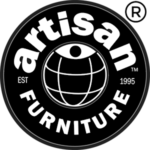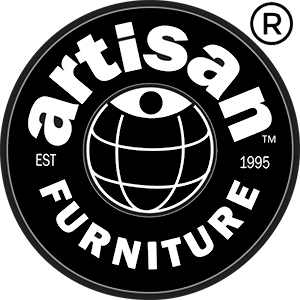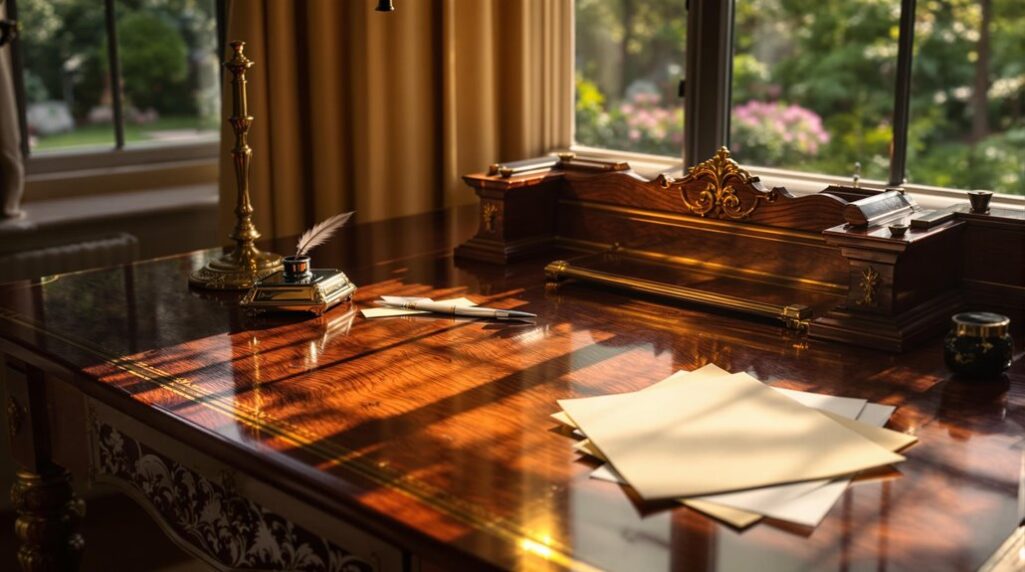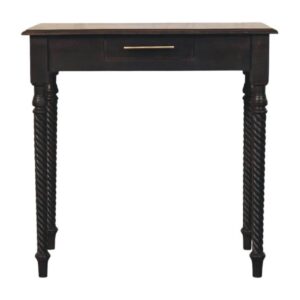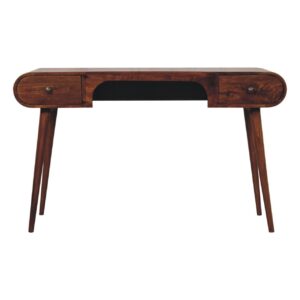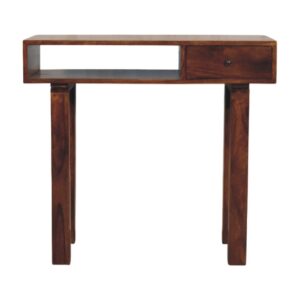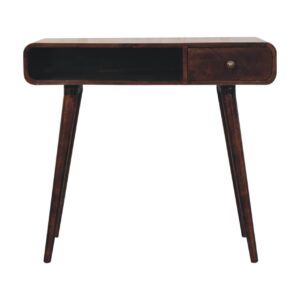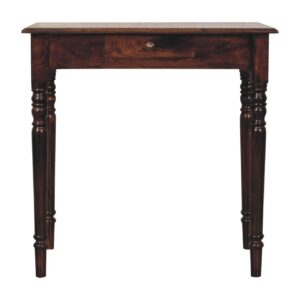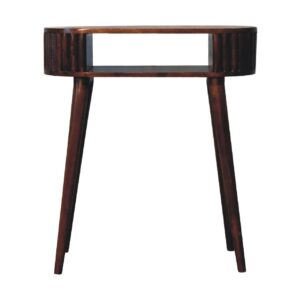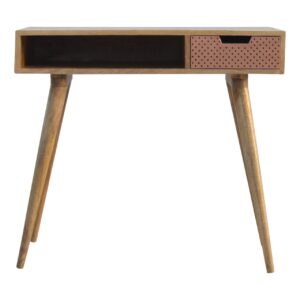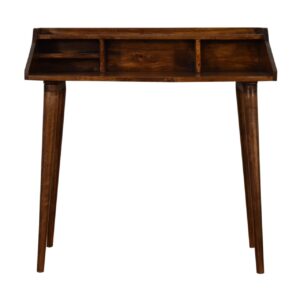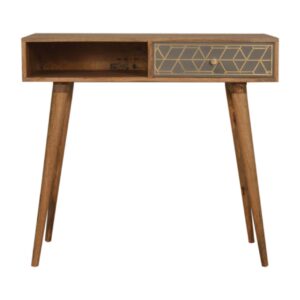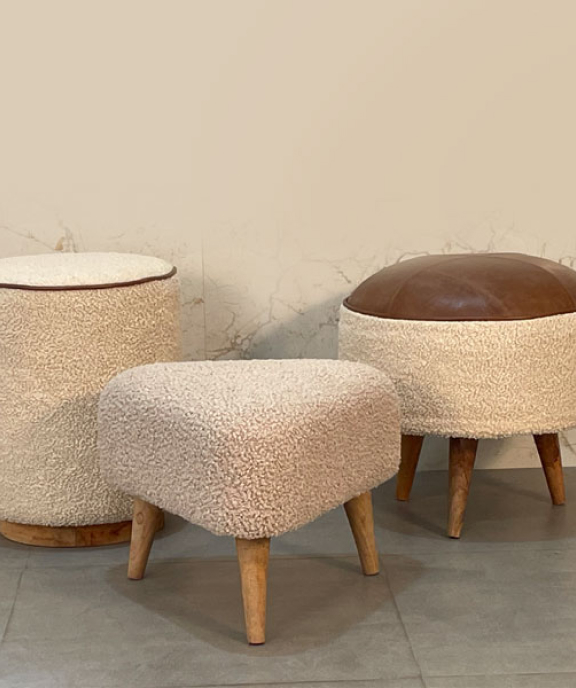A writing desk is characterized by several essential features that enhance functionality and comfort. You need an ergonomic design that allows proper posture, with height adjustments for your typing style. Sufficient workspace is vital, balancing size with the room's layout to avoid clutter. Quality materials, like solid wood or metal, guarantee durability and aesthetic appeal. Built-in storage solutions help keep your workspace organized and efficient. Additionally, personalized elements, such as style and accessories, can inspire creativity. Understanding these components will guide you in selecting the ideal writing desk that suits your needs and preferences. Further insights await you.
Essential Features of Writing Desks
When you're choosing a writing desk, it's crucial to take into account its essential features to guarantee it meets your needs. Start by considering the desk's size; it should fit comfortably in your space while providing ample surface area for your tasks. Next, think about storage options. Drawers and shelves can help keep your workspace organized and clutter-free. Additionally, look for ergonomic design elements, such as height adjustability, which can enhance comfort during long writing sessions. Don't overlook cable management features, as they help maintain a tidy appearance by concealing cords. Finally, assess the desk's stability; a sturdy construction prevents wobbling, ensuring a more productive environment. Each of these elements contributes to a functional and efficient writing experience.
Importance of Material Selection
When choosing a writing desk, the material you select plays a vital role in its overall performance and appearance. Durable materials guarantee your desk withstands daily use, contributing to longevity, while aesthetically pleasing options enhance your workspace's visual appeal. Additionally, the right material can impact functionality and usability, making it important to take into account how each choice aligns with your specific needs.
Durability and Longevity
Choosing the right materials for a writing desk is essential if you want it to withstand daily use and retain its appeal over time. Solid woods, like oak or maple, are popular choices due to their strength and resistance to wear. Plywood and engineered wood can provide durability at a lower cost, but make certain they're well-constructed to avoid warping. Metal frames can add stability and longevity, particularly when combined with wood surfaces. When selecting finishes, opt for those that protect against scratches and stains, as this contributes to the desk's lifespan. Additionally, consider the desk's intended use; heavier materials may be necessary for more demanding tasks. Ultimately, investing in quality materials will pay off in reduced maintenance and extended usability.
Aesthetic Appeal
A writing desk isn't just a functional piece of furniture; it's also a statement about your personal style. The materials you choose greatly impact the desk's aesthetic appeal, influencing how it complements your space. For instance, solid wood exudes warmth and elegance, while metal options provide a sleek, modern look. Additionally, the finish—whether polished, distressed, or matte—can dramatically alter the visual texture and feel of the desk. The color palette plays an essential role as well; neutral tones tend to blend seamlessly, while bold hues can create a striking focal point. Ultimately, selecting the right materials not only enhances the desk's beauty but also reflects your taste and the overall ambiance of your workspace.
Functionality and Usability
While aesthetics play an essential role in your choice of a writing desk, the functionality and usability are equally important, especially when it comes to material selection. The right materials can enhance durability, stability, and ease of maintenance. For example, hardwood offers strength and longevity, making it ideal for a desk that withstands daily use. Conversely, particleboard may be more affordable but can suffer from wear and tear over time. Additionally, consider the finish; a smooth surface can facilitate writing and typing, while textures can add grip but may hinder movement. Ultimately, selecting the appropriate material not only affects the desk's lifespan but also impacts your overall productivity, as a well-chosen desk supports your work habits and comfort.
Design Styles to Consider
When it comes to selecting a writing desk, several design styles can elevate your workspace and reflect your personality. First, consider a traditional style, characterized by rich woods and intricate carvings, offering a timeless elegance. If you prefer a modern aesthetic, opt for sleek lines and minimalist designs that emphasize functionality. Industrial styles, featuring metal and reclaimed wood, can create a rugged, contemporary vibe. Alternatively, a rustic desk, with its distressed finish and natural materials, brings warmth and charm to your space. Finally, eclectic styles allow for personalized combinations of various elements, showcasing your unique taste. Each style not only serves a functional purpose but also enhances the overall atmosphere of your workspace, making it essential to choose wisely.
Size and Space Considerations
Choosing the right design style for your writing desk is just the beginning; size and space considerations play a vital role in making the right selection. First, assess the available area in your room. Measure the space where you plan to place your desk, ensuring you leave enough room for movement and additional furniture. Consider the desk's dimensions, as a larger desk can offer more workspace but may overwhelm a small area. You should also think about the height and width in relation to your own needs; a desk that feels cramped can hinder productivity. Finally, remember to account for storage options, as built-in shelves or drawers can optimize your workspace without taking up extra room.
Ergonomics and Comfort Factors
To guarantee you stay comfortable during long writing sessions, it's essential to prioritize ergonomics when selecting your desk. An ergonomic desk should align with your body's natural posture, reducing strain on your back, neck, and wrists. Look for a desk height that allows your elbows to form a 90-degree angle while typing. Ideally, your chair should support your lower back, and your feet should rest flat on the ground. Additionally, consider the desk surface; it should provide enough space for your monitor to be at eye level, promoting a neutral head position. By incorporating these ergonomic principles, you'll enhance your comfort and productivity, allowing for more focused and efficient writing sessions without the discomfort that can lead to fatigue or injury.
Storage Solutions and Organization
A well-organized writing desk can greatly enhance your workflow and creativity. To achieve this, consider incorporating various storage solutions that cater to your specific needs. Utilize drawer organizers to keep pens, paper clips, and other small items easily accessible. Opt for vertical storage options, like shelves or wall-mounted organizers, to maximize space while keeping frequently used materials within reach. A filing system is essential for managing documents and notes; categorize them to streamline your workflow. Additionally, consider investing in a cable management system to reduce clutter from cords and chargers. By implementing these organization strategies, you'll create an efficient workspace that fosters productivity and helps you maintain focus on your writing tasks.
Personalization and Aesthetic Touches
Personalizing your writing desk can transform it into an inspiring and motivating workspace. You can start by selecting a color scheme that reflects your personality, which enhances your productivity. Adding personal items, like framed photos or artwork, creates a sense of comfort and familiarity. Consider incorporating functional decor, such as stylish organizers or unique stationery, that not only serve a purpose but also elevate the desk's aesthetic appeal. Plants can introduce a natural element, promoting well-being and creativity. Additionally, investing in quality lighting, like a designer desk lamp, can improve focus and reduce eye strain. Ultimately, these personalization strategies not only enhance the visual appeal of your desk but also create an environment conducive to creativity and concentration.
